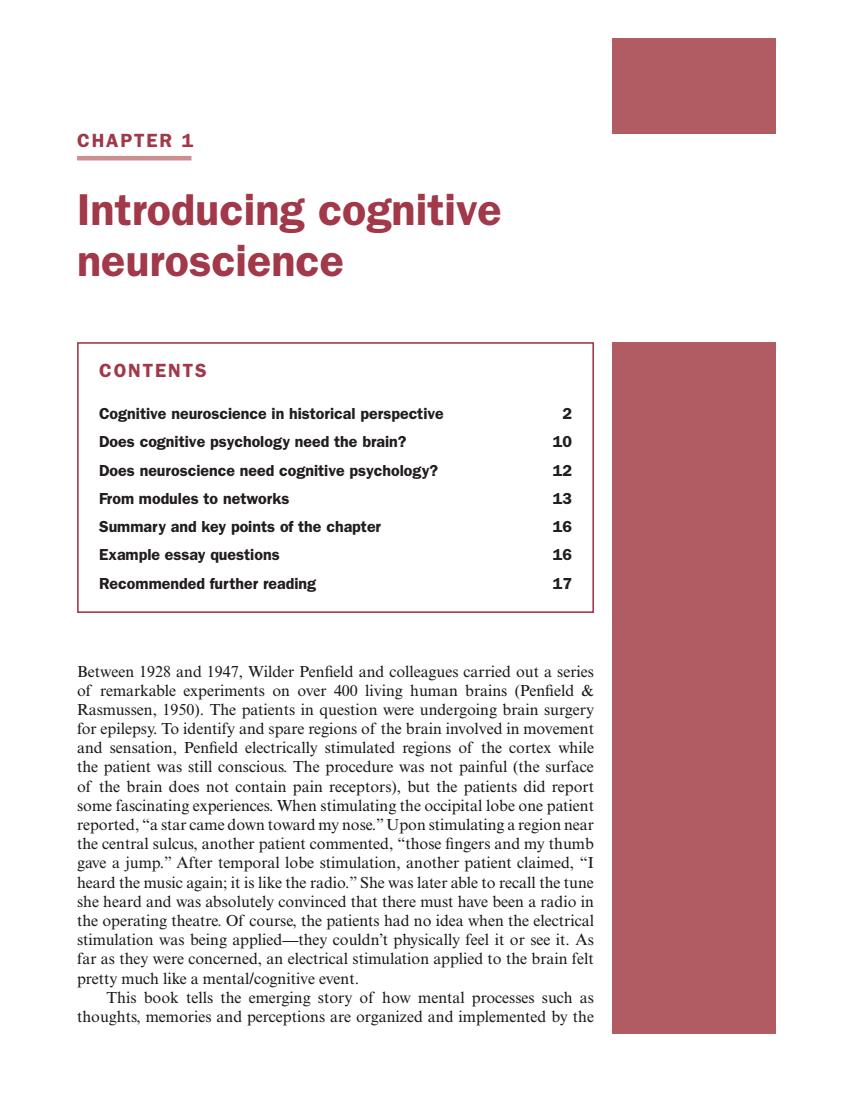正在加载图片...

CHAPTER 1 Introducing cognitive neuroscience CONTENTS Cognitive neuroscience in historical perspective 2 Does cognitive psychology need the brain? 10 Does neuroscience need cognitive psychology? 12 From modules to networks 13 Summary and key points of the chapter 16 Example essay questions 16 Recommended further reading 17 Between 1928 and 1947.Wilder Penfield and colleagues carried out a series of remarkable experiments on over 400 living human brains(Penfield Rasmussen,1950).The patients in question were undergoing brain surgery for epilepsy.To identify and spare regions of the brain involved in movement and sensation,Penfield electrically stimulated regions of the cortex while the patient was still conscious.The procedure was not painful (the surface of the brain does not contain pain receptors),but the patients did report some fascinating experiences.When stimulating the occipital lobe one patient reported,"a star came down toward my nose."Upon stimulating a region near the central sulcus,another patient commented,"those fingers and my thumb gave a jump."After temporal lobe stimulation,another patient claimed,"I heard the music again;it is like the radio."She was later able to recall the tune she heard and was absolutely convinced that there must have been a radio in the operating theatre.Of course,the patients had no idea when the electrical stimulation was being applied-they couldn't physically feel it or see it.As far as they were concerned,an electrical stimulation applied to the brain felt pretty much like a mental/cognitive event. This book tells the emerging story of how mental processes such as thoughts,memories and perceptions are organized and implemented by the Between 1928 and 1947, Wilder Penfield and colleagues carried out a series of remarkable experiments on over 400 living human brains (Penfield & Rasmussen, 1950). The patients in question were undergoing brain surgery for epilepsy. To identify and spare regions of the brain involved in movement and sensation, Penfield electrically stimulated regions of the cortex while the patient was still conscious. The procedure was not painful (the surface of the brain does not contain pain receptors), but the patients did report some fascinating experiences. When stimulating the occipital lobe one patient reported, “a star came down toward my nose.” Upon stimulating a region near the central sulcus, another patient commented, “those fingers and my thumb gave a jump.” After temporal lobe stimulation, another patient claimed, “I heard the music again; it is like the radio.” She was later able to recall the tune she heard and was absolutely convinced that there must have been a radio in the operating theatre. Of course, the patients had no idea when the electrical stimulation was being applied—they couldn’t physically feel it or see it. As far as they were concerned, an electrical stimulation applied to the brain felt pretty much like a mental/cognitive event. This book tells the emerging story of how mental processes such as thoughts, memories and perceptions are organized and implemented by the CONTENTS Cognitive neuroscience in historical perspective 2 Does cognitive psychology need the brain? 10 Does neuroscience need cognitive psychology? 12 From modules to networks 13 Summary and key points of the chapter 16 Example essay questions 16 Recommended further reading 17 CHAPTER 1 Introducing cognitive neuroscience